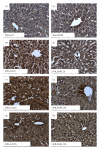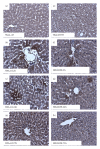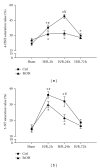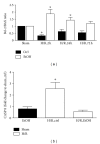Acute ethanol gavage attenuates hemorrhage/resuscitation-induced hepatic oxidative stress in rats
- PMID: 22550557
- PMCID: PMC3328156
- DOI: 10.1155/2012/983427
Acute ethanol gavage attenuates hemorrhage/resuscitation-induced hepatic oxidative stress in rats
Abstract
Acute ethanol intoxication increases the production of reactive oxygen species (ROS). Hemorrhagic shock with subsequent resuscitation (H/R) also induces ROS resulting in cellular and hepatic damage in vivo. We examined the role of acute ethanol intoxication upon oxidative stress and subsequent hepatic cell death after H/R. 14 h before H/R, rats were gavaged with single dose of ethanol or saline (5 g/kg, EtOH and ctrl; H/R_EtOH or H/R_ctrl, resp.). Then, rats were hemorrhaged to a mean arterial blood pressure of 30 ± 2 mmHg for 60 min and resuscitated. Two control groups underwent surgical procedures without H/R (sham_ctrl and sham_EtOH, resp.). Liver tissues were harvested at 2, 24, and 72 h after resuscitation. EtOH-gavage induced histological picture of acute fatty liver. Hepatic oxidative (4-hydroxynonenal, 4-HNE) and nitrosative (3-nitrotyrosine, 3-NT) stress were significantly reduced in EtOH-gavaged rats compared to controls after H/R. Proapoptotic caspase-8 and Bax expressions were markedly diminished in EtOH-gavaged animals compared with controls 2 h after resuscitation. EtOH-gavage increased antiapoptotic Bcl-2 gene expression compared with controls 2 h after resuscitation. iNOS protein expression increased following H/R but was attenuated in EtOH-gavaged animals after H/R. Taken together, the data suggest that acute EtOH-gavage may attenuate H/R-induced oxidative stress thereby reducing cellular injury in rat liver.
Figures





Similar articles
-
Plant polyphenols attenuate hepatic injury after hemorrhage/resuscitation by inhibition of apoptosis, oxidative stress, and inflammation via NF-kappaB in rats.Eur J Nutr. 2012 Apr;51(3):311-21. doi: 10.1007/s00394-011-0216-1. Epub 2011 Jun 23. Eur J Nutr. 2012. PMID: 21698494
-
Effects of acute ethanol gavage on intestinal integrity after hemorrhage/resuscitation.Scand J Gastroenterol. 2013 Apr;48(4):448-58. doi: 10.3109/00365521.2013.772228. Scand J Gastroenterol. 2013. PMID: 23517294
-
Polyphenols of Camellia sinenesis decrease mortality, hepatic injury and generation of cytokines and reactive oxygen and nitrogen species after hemorrhage/resuscitation in rats.BMC Complement Altern Med. 2010 Aug 24;10:46. doi: 10.1186/1472-6882-10-46. BMC Complement Altern Med. 2010. PMID: 20735845 Free PMC article.
-
Simvastatin reduces mortality and hepatic injury after hemorrhage/resuscitation in rats.Shock. 2010 Jul;34(1):46-54. doi: 10.1097/SHK.0b013e3181cd8d05. Shock. 2010. PMID: 19997050
-
Effects of alcohol and oxidative stress on liver pathology: the role of the mitochondrion.Alcohol Clin Exp Res. 2002 Jun;26(6):907-15. Alcohol Clin Exp Res. 2002. PMID: 12068261 Free PMC article. Review.
Cited by
-
Ethyl pyruvate ameliorates hepatic injury following blunt chest trauma and hemorrhagic shock by reducing local inflammation, NF-kappaB activation and HMGB1 release.PLoS One. 2018 Feb 8;13(2):e0192171. doi: 10.1371/journal.pone.0192171. eCollection 2018. PLoS One. 2018. PMID: 29420582 Free PMC article.
-
Myeloid knockout of HIF-1 α does not markedly affect hemorrhage/resuscitation-induced inflammation and hepatic injury.Mediators Inflamm. 2014;2014:930419. doi: 10.1155/2014/930419. Epub 2014 Jun 1. Mediators Inflamm. 2014. PMID: 24991092 Free PMC article.
-
Short-Chain Alcohols Upregulate GILZ Gene Expression and Attenuate LPS-Induced Septic Immune Response.Front Immunol. 2020 Feb 3;11:53. doi: 10.3389/fimmu.2020.00053. eCollection 2020. Front Immunol. 2020. PMID: 32117233 Free PMC article.
-
Chronic ethanol feeding modulates inflammatory mediators, activation of nuclear factor-κB, and responsiveness to endotoxin in murine Kupffer cells and circulating leukocytes.Mediators Inflamm. 2014;2014:808695. doi: 10.1155/2014/808695. Epub 2014 Jan 29. Mediators Inflamm. 2014. PMID: 24623963 Free PMC article.
-
Suppression of the interleukin-1ß-induced inflammatory response of human Chang liver cells by acute and subacute exposure to alcohol: an in vitro study.Croat Med J. 2018 Apr 30;59(2):46-55. doi: 10.3325/cmj.2018.59.46. Croat Med J. 2018. PMID: 29740988 Free PMC article.
References
-
- Mokdad AH, Marks JS, Stroup DF, Gerberding JL. Actual causes of death in the United States, 2000. Journal of the American Medical Association. 2004;291(10):1238–1245. - PubMed
-
- Li G, Keyl PM, Smith GS, Baker SP. Alcohol and injury severity: reappraisal of the continuing controversy. Journal of Trauma. 1997;42(3):562–569. - PubMed
-
- Rehm J, Room R, Graham K, Monteiro M, Gmel G, Sempos CT. The relationship of average volume of alcohol consumption and patterns of drinking to burden of disease: an overview. Addiction. 2003;98(9):1209–1228. - PubMed
-
- Rivara FP, Jurkovich GJ, Gurney JG, et al. The magnitude of acute and chronic alcohol abuse in trauma patients. Archives of Surgery. 1993;128(8):907–913. - PubMed
Publication types
MeSH terms
Substances
LinkOut - more resources
Full Text Sources
Medical
Research Materials

